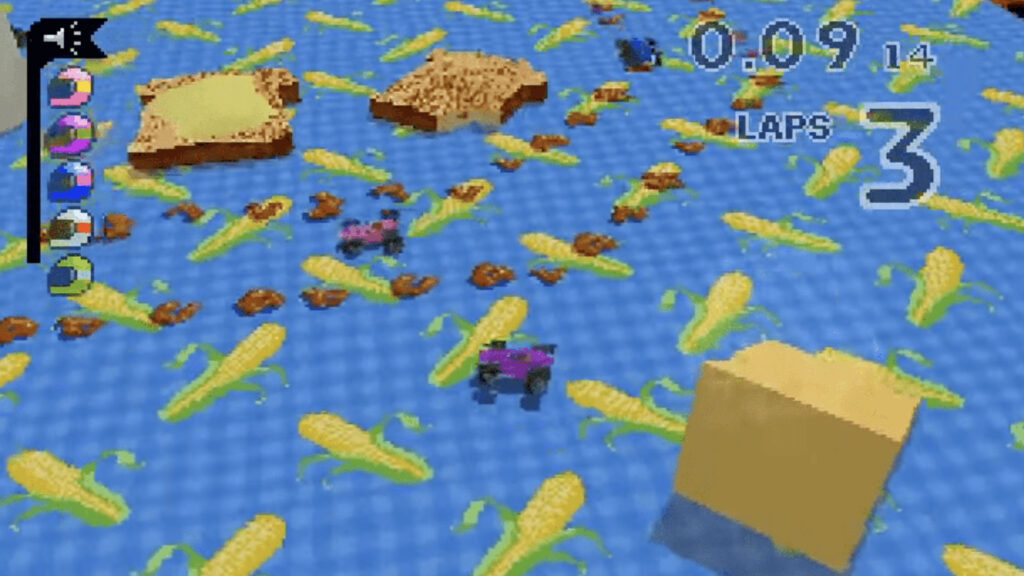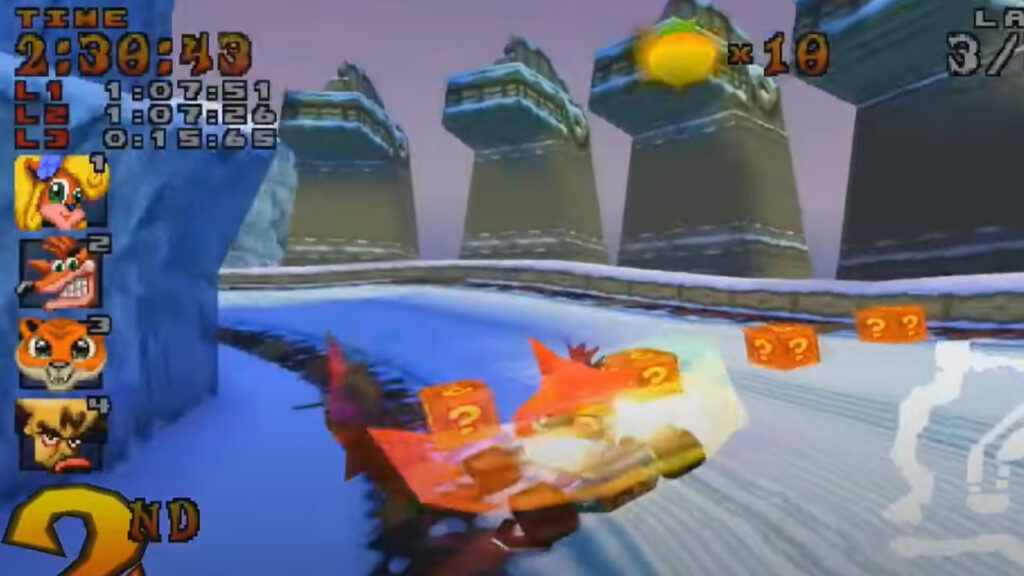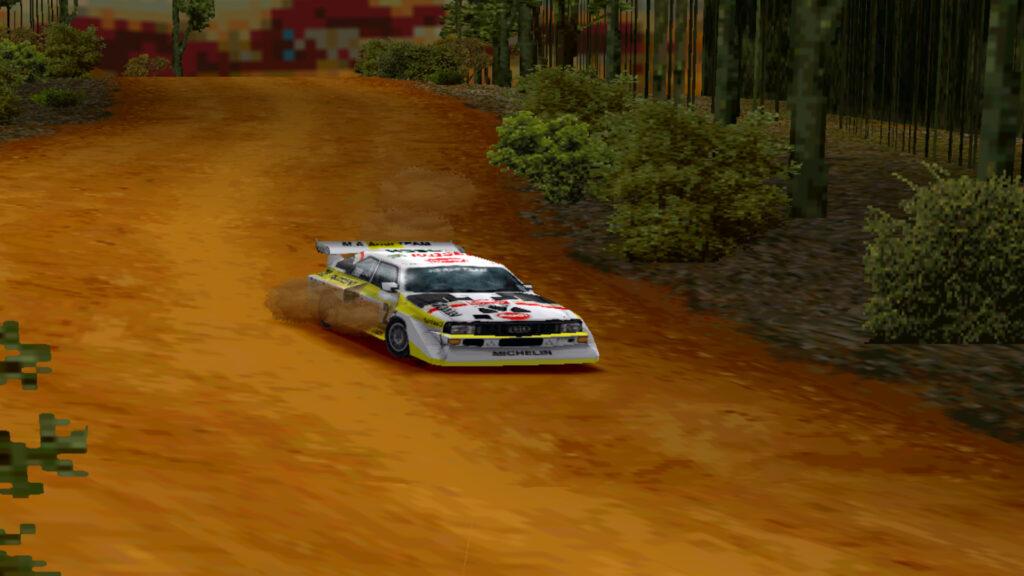Shop sim racing equipment
[adinserter name=”Fanatec”]
[adinserter name=”Next Level Racing”]
[adinserter name=”GT Omega”]
[adinserter name=”Thrustmaster”]
Words by: Ross McGregor, Martin Bigg and Thomas Harrison-Lord
The three contributors to this article can still vividly remember the day they first tried (an original) PlayStation, so the 30th anniversary of Sony’s debut dedicated gaming console is rather humbling.
Are we really that old?
Yes.

The first Playstation (or PSX and later PSOne) was released on 3rd December 1994.
After a brief dalliance with Nintendo, the Japanese electronics company went its own way with a compact disc-based system – and it is not an exaggeration to say its relatively affordable price and stellar games catalogue changed the entertainment industry forever.
That rectangular device, seemingly made from the same grey plastic as a cutlery draw organiser, lit up our imaginations.
The Traxion team sit here, being video game and motorsport journalists because the PlayStation allowed us to drive cars. At home. After our homework was completed, naturally.

And we are sure we aren’t alone in our respect for the boxy device. With that in mind, here are Traxion’s top 10 racing games on the original PlayStation – and yes, it was had to not simply list two Gran Turismo games, three TOCA games and two Colin McRae Rally titles, so we’ve kept it to one game per franchise.
Also, the nearly-made-it list includes the likes of Speed Freaks, Twisted Metal, Motor Toon Grand Prix, NASCAR Rumble, Rollcage, LEGO Racers and Need for Speed. Let us know your top 10 in the comments below.
10. Wipeout 2097 / Wipeout XL
WipEout, or wipE′out″, or perhaps Wipeout. No one is quite sure – in fact, the PlayStation packaging spine simply reads WIPEOUT. So it could be that too.
What is more certain is the futuristic racer’s speed. It was impossible to gain the same sense of rapid forward motion. Many forgot, too, that while F-Zero is remembered as an anti-gravity video game pioneer, Wipeout beat it to the 3D punch in 1995 by some three years.
Building on the original, this is the sequel (2097 in Europe, XL in North America and Japan) which arrived just one year later.

Despite that relatively short gestation period, improvements to ship handling, greatly enhanced speed and a thumping soundtrack (that featured The Prodigy’s Firestarter), this hit the zeitgeist and a formula that all subsequent Wipeout titles followed.
9. Micro Machines V3
Based on the popular toy line, the Micro Machines game series originated on the eight-bit Nintendo Entertainment System. Players would race tiny tanks, cars and powerboats on gigantic environments ranging from breakfast tables to workshop desks while avoiding everyday objects.

Hardware limitations meant the early Micro Machines games were top-down and 2D. With Micro Machines V3, the series made the leap to 3D on the PlayStation in 1997, bringing a new sense of scale to the environments as you raced past giant cereal boxes and maple syrup bottles.
Micro Machines V3’s main hook, though, was its brilliant multiplayer, where players are eliminated if they fall behind off-screen.
With up to eight players (providing you had two multitaps) attacking each other with giant hammers or ramming each other off the track, Micro Machines V3’s anarchic multiplayer matches made it the PlayStation’s ultimate party racer. We suspect it ruined a few friendships…
8. Crash Team Racing
By the late ‘90s, the kart-racing-spin-off-from-a-platforming-game sub-genre had well and truly been defined by Mario Kart.
Nothing else could come close, although that didn’t stop some from trying.
Crash Team Racing was one such rival and became the archetypal kart racer for those with a PlayStation, as opposed to an SNES or N64.
In some respects a clumsy pastiche of its Nintendo progenitor, following the same basic template and pasting it onto a rival console worked because at least CTR was fun.

It helped that the environment it was set within was so beguiling, and by the time Aku Aku shouted “ooga-booga!” (the Crash equivalent of Mario’s star mode) we were sold. Fire up the Multitap!
7. Destruction Derby 2
Destruction Derby’s crumpling cars were groundbreaking, but the 1996 sequel took the carnage to the next level. Inspired by American stock car racing instead of UK banger racing, Destruction Derby 2 was faster and more extreme than its predecessor.

Unlike the first game, cars could flip over and go airborne, resulting in more spectacular crashes. Damage modelling was also significantly improved with detachable panels, while the wider tracks incorporated shortcuts, elevation changes and huge jumps compared to the original’s flat circuits.
Destruction bowls were the real highlight though, where the goal was to cause as much carnage as possible and be the last car standing. Here, the overly aggressive AI was particularly noticeable, with swarms of cars constantly smashing you up.
6. Formula 1 97
Developed by Bizarre Creations, Formula 1 97 was the second of the studio’s officially licensed F1 games, featuring the mellifluous tones of the great Murray Walker, ably assisted by Martin ‘You’re right there, Murray’ Brundle.

All of 1997’s F1 tracks are present and correct, but not all of the drivers, with Jacques Villeneuve absent due to a licence clash (Villeneuve apparently had a video game deal with Ubisoft at the time, which led to the forgettable Speed Challenge: Jacques Villeneuve’s Racing Vision).
F1 97’s visuals took a huge step forward over its predecessor, but the biggest change was the split of gameplay between Arcade and Grand Prix modes, which offered all fans a chance to enjoy virtual F1 racing regardless of their ability.
Allied with believable car handling and a two-player split-screen mode, F1 97 was the finest Formula 1 game on PlayStation by some margin. Anyone who played Formula 1 98, which Bizarre Creations did not develop, would strongly agree with this statement…
5. Ridge Racer Type 4
Released in 1999 in Europe and North America, Ridge Racer Type 4 maintained the series’ deliciously simple arcadey roots, placing heavy emphasis on the art of drifting.

From the game’s slightly creepy intro movie, heavily featuring female ‘virtual icon’ Reiko Nagase, it was clear RR4 was going to be the most visually impressive entry in the series.
Fortunately, it also had a much-improved career mode to fall back on, where players could drive for one of four teams, unlocking more cars and performance by racing well (Micro Mouse Mappy FTW!). There was also a rudimentary storyline to follow,

RR4 also introduced a two-player local split-screen mode to the series, so you and a friend could both enjoy the oddly soothing blend of smooth jazz and drum and bass that made up the game’s soundtrack.
4. Driver
Driver was ahead of the curve when it screeched onto the PlayStation in 1999. While GTA was still a 2D top-down series at this point, Reflections Interactive’s ode to Hollywood car chases let you burn rubber in four fully 3D cities (five if you count the secret Newcastle level…), sliding around 90-degree turns and escaping police in burly 1970s muscle cars.

The wow factor of driving around a 3D open environment on a console several years before GTA III can’t be overstated. There was even a novel film director mode, where you could replay the action and create mini car chase films.
However, Driver is perhaps best known for its notoriously tricky tutorial, where you must complete a checklist of manoeuvres in a car park within a tight time limit. You know it’s too difficult when even seven-time Formula 1 World Champion Lewis Hamilton can’t beat it.
3. Colin McRae Rally
Codemasters was on a roll in 1998. After TOCA 2, the Southam-based studio released Colin McRae Rally, launching an off-road gaming dynasty founded on its eponymous star’s mantra of ‘if in doubt, flat out’.

CMR possessed a weighty handling model so intuitive that you could just about forgive it for using an outdated car roster from the 1997 World Rally Championship.
Thankfully, the car list was superb, featuring McRae’s iconic Subaru Impreza, plus its WRC rivals Mitsubishi, Toyota and Ford. McRae’s co-driver Nicky Grist also added his dulcet tones to the on-screen pacenotes.

Add in several classic rally cars, eight countries to drive in (including super special stages!) and some of the best video game cheats ever seen, and you’ve got a certified PlayStation rallying classic.
And it had a UFO. Yes, really.
2. TOCA 2: Touring Cars
TOCA Touring Car Championship was a revelation when released back in 1997 for the PlayStation, perfectly evoking the cut and thrust of the BTCC and its awesome Super Touring cars.

However, just a year later, Codemasters released TOCA 2: Touring Cars, which improved the formula further by having better graphics, more motorsport disciplines and more tracks than its predecessor.
While the car handling was largely similar (knife-edge stuff, basically), it introduced the BTCC’s new-for-’98 pit stop races, which was an interesting diversion in quite a staid genre.
TOCA 2 was no Gran Turismo in terms of polish, however, but it felt like the more approachable, down-to-earth alternative, where a bit of panel rubbing was deemed entirely acceptable.
Kazunori Yamauchi would never approve of that…
1. Gran Turismo 2
No, we can’t imagine the Gran Turismo auteur would, as Gran Turismo 2 certainly didn’t feature a crunching damage system like the aforementioned TOCA 2.

But what it had instead, and bucketloads of them, was cars. Lots of cars. Somewhere around 650. And The Cardigans.
Having originally wanted to make movies, Yamauchi joined Sony’s PlayStation project in the early days and even released a racing game at the console’s launch – Motor Toon Grand Prix. A sequel would follow soon after, followed by the pivotal first Gran Turismo title.
But we think it is the 1999 sequel that is the series’ PSOne zenith, replete with two licenced tracks (Laguna Seca and Pikes Peak) and such shining automobile examples like the Dodge Stratus, Citroën Xantia and Renault Laguna.

Such humdrum machines should have been left on a motorway with a photocopier sales representative. But, the appeal of GT2 was being able to drive the ordinary, followed by the lunacy. Take the Opel Astra and a Suzuki hillclimb special.
Yes, the licence tests appeal endured, the menu music was suitably jazzy and the main career lengthy. It is the passion displayed for the automobile’s existence, however, that makes Gran Turismo 2 the greatest PlayStation (PSX) racing video game of all time.





Chat with the Community
Sign Up To CommentIt's completely Free